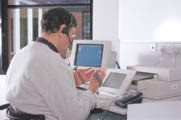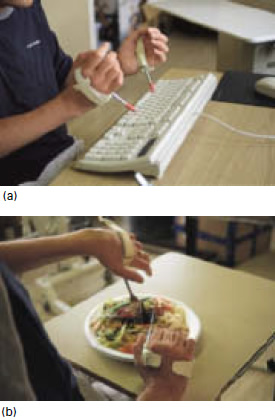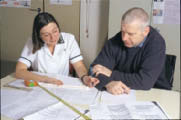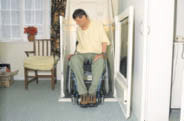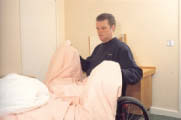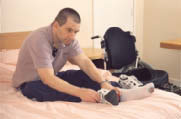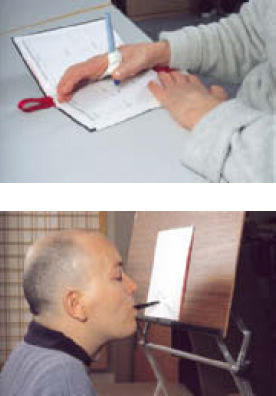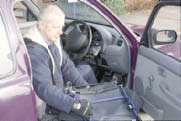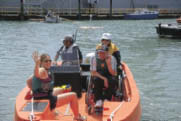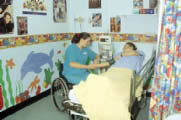Occupational therapy after spinal cord injury
The months in hospital after a spinal cord injury are an extremely difficult period for patients as they gradually adjust to what may be a lifetime of disability.
Occupational therapists are concerned with assisting patients to reach the maximum level of functional physical and psychological independence depending on the extent of the impairment, their home and social situation. Whalley Hammell suggests independence is not a physical state but more an attitude in which an individual takes on responsibility, solves problems, and establishes goals. Empowering an individual to make an informed choice about the way they choose to live their lives is not achieved in isolation, and therefore close working relationships with other professionals are essential.
The skills of the occupational therapist lie in assisting patients to overcome their difficulties, often by considering alternative methods and equipment to assist them with personal care, domestic tasks, and communication. The occupational therapist is also involved with advising people on home modifications, mobility including wheelchairs, driving and transport, returning to work, college or school, and the pursuit of leisure activities and hobbies.
Hand and upper limb management
Individual assessment of the hand and upper limb of tetraplegic patients is essential to maintain their hands in the optimum position for function.
Curtin describes the general acute management of patients with complete spinal cord injury, based on the level of lesion.
Hand management of patients with incomplete lesions needs close monitoring and if motor function improves activities are performed to enable the patient to achieve their maximum potential.
Tetraplegic patients with active wrist extensors should be encouraged to participate in activities to strengthen these muscles and to facilitate the use of their tenodesis grip. This occurs in the individual with a complete spinal cord lesion at C6 who is able to use active wrist extension to produce a grip between thumb and index fingers.
Some tetraplegic patients may require a variety of splints, such as those for writing and typing, wrist support splints, feeding straps, or pushing gloves, to enable them to carry out their daily activities. All splints are made individually for each patient by the therapist.
Some tetraplegic patients can benefit from reconstructive surgery to the hands or upper limbs, or both, but as surgery is not necessarily appropriate for all patients, careful preoperative assessment by a multidisciplinary team is vital. Staff in the spinal centre should carefully monitor postoperative care.
Home resettlement
Establishing early dialogue with the patient, the patient’s family and friends is vital to enable the occupational therapist to be in a position to offer early advice and reassurance regarding living in the community. Early contact with the local social services is made as soon as possible after admission.
When an individual has a home to which they wish to return to, a joint visit may be carried out to give advice on its accessibility for overnight stays and for long-term resettlement. When an individual does not have a suitable home to return to alternatives are discussed, i.e. application to local authority for rehousing, purchase or rental of a new property.
An assessment visit involves a team from the spinal unit, including the occupational therapist and representatives from the patient’s home area — usually the occupational therapist and social worker/care manager and the patient’s family.
The visit begins the lengthy processes of planning for the patient’s discharge and providing accessible accommodation. The timing usually means that the patient is unable to travel, and, although it is less than satisfactory for the patient to be absent, all ideas are discussed and decisions made with him or her and the family.
Recommendations are made to enable weekends to be spent away from hospital. Although facilities may be far from ideal, i.e. a hospital bed may have to be positioned in the living room, with no access to bathroom facilities, it is well recognised that time spent in the community provides the patient, family and friends with essential learning opportunities. Weekends away begin when the patient and family or friends feel confident to be away from the hospital. Enabling this to occur may involve the whole team in teaching techniques, procedures and instruction in the use of equipment to both patient and family.
Spending time away from the hospital may enable the patient, their family and friends to decide upon what plans they wish to make for long-term resettlement in the community.
If long-term alterations to a property are an option, grant aid towards the alterations may be available from the patient’s local council and/or social services department, depending on the family’s financial circumstances. The procedures involved in making alterations to a property require careful thought and planning and may take many months before completion.
As well as the availability of suitable accommodation, the organising of an appropriate care package may be necessary, which involves the whole team and may take time to organise.
In the event of completion of a patient’s rehabilitation occurring before long-term accommodation is accessible or available, it may be necessary for alternative interim accommodation to be sought.
Activities of daily living
Once tetraplegic patients are out of bed and have started work on strengthening and balance, they begin to explore methods to relearn eating, drinking, washing, brushing their hair, cleaning their teeth, and shaving. Activities can be restricted due to the necessity of wearing a hard collar for the initial period of rehabilitation. These activities often entail the use of adapted tools or splints and straps made by the occupational therapist. The patient may need to relearn writing skills and may also explore the use of a computer, telephone, page- turner, and environmental control system.
As the patient becomes more confident and the wearing of a hard collar or brace all day is discontinued, he or she is able to progress to tasks involving bed mobility, in preparation for dressing, transfers, showering, and domestic activities. This can cover the whole range of domestic living and include being able to make a cup of tea, using a microwave, washing machine, vacuum cleaner or changing a duvet cover independently. Despite the patient’s social situation they should be given the opportunity to relearn these activities.
For patients who are unable to perform or assist in transfers the feasibility of being able to participate in hoisting may be pursued.
Functional ability and anticipated level of independence of patients with complete tetraplegia:
| Tetraplegia level | Functional ability |
| Complete lesion below C3 | - Diaphragm paralysed requires tracheostomy with permanent ventilation or diaphragm pacing - Dependent on others for all personal and domestic care - Able to use powered wheelchair with chin, head or breath control - Able to use voice-activated computer - Able to use electrically powered page-turner with switch - Able to use environmental control equipment with switch, usually mouthpiece |
| Complete lesion below C4 | - Able to breathe independently using diaphragm - Able to shrug shoulders - Dependent on others for all personal and domestic care - Able to use a powered wheelchair with chin control - Able to use computer, either voice activated or using head switch or mouthstick - Able to use environmental control equipment with mouthpiece as switch |
| Complete lesion below C5 | - Has shoulder flexion and abduction, elbow flexion and supination - Able to participate in some aspects of personal and domestic care, i.e. eating, cleaning teeth using a wrist support and universal cuff - Able to make signature using individually designed splint and wrist support - Able to propel manual wheelchair short distances on level uncarpeted ground wearing pushing gloves and/or wrist supports - Able to use powered wheelchair with joystick control for functional use - May be able to assist with transfer from wheelchair onto level surfaces using a sliding board and an assistant - Able to drive from wheelchair in an accessible vehicle - Able to use environmental control equipment using a switch |
| Complete lesion below C6 | - Able to extend wrists - Able to perform some aspects of personal and domestic care using a universal cuff - Able to make a signature using an individually designed splint - Able to dress upper half of body independently, but may require some assistance with dressing lower half of body - Able to propel wheelchair, including slopes - May be independent in bed, car, and shower chair transfers - Able to drive an automatic car with hand controls |
| Complete lesion below C7 | - Full wrist movement and some hand function, but no finger flexion or fine hand movements - Able to be independent in bed, car, shower chair, and toilet transfers - May require assistance/equipment to assist with wheelchair to floor transfers - Able to dress and undress independently - Able to drive an automatic car with hand controls |
| Complete lesion below C8 | - All hand muscles except intrinsics preserved - Wheelchair independent but may have difficulty going up and down kerbs - Able to drive an automatic car with hand controls |
| Complete lesion below T1 | - Complete innervation of arms - Wheelchair independent - Able to drive an automatic car with hand controls |
These expectations are general and depend upon the patient’s age, physical proportions, physical stamina and agility, degree of spasticity and motivation. In incomplete spinal cord lesions, where there can be variable potential for neurological recovery, it may not be possible to predict functional outcome, which can lead to increased anxiety for the patient.
The level of independence achieved by children not only depends on their size and functional ability but the attitude of their parents. As the adult with a spinal cord lesion becomes older their ability to maintain their level of independence may diminish and require review.
Communication
For tetraplegic patients unable to use their upper limbs functionally with standard communication systems, the role of the occupational therapist is to enable the patient to access alternative systems. Individual writing splints or mouthsticks may be made to enable those with limited writing skill to make a signature, which can be important to an individual for both business and personal correspondence. Alternative methods of being able to turn the pages of books, magazines and newspapers may be pursued.
Trial and selection of electrically powered equipment includes telephone, computer and assessment of environmental control systems, which can enable the individual to operate via a switch a range of functions, including television, video, intercom, computer, lights, radio, and accessing the telephone.
Mobility
Wheelchairs
Whenever possible an individual is encouraged to propel his or her wheelchair as soon as they are able. Pushing gloves and/or wrist supports may be required.
As soon as is practicable liaison occurs between the spinal centre staff, the patient and the patient’s local district wheelchair service. They are able to assess and provide wheelchairs from a range, which includes self-propelling, lightweight, indoor powered, indoor/outdoor powered and attendant-operated wheelchairs. Initially a patient may be issued with a basic wheelchair and reassessed once he or she is able to participate in choosing a long-term wheelchair. The occupational therapist should be able to guide the individual to trial and select a wheelchair with features that suit the patient’s functional ability and lifestyle.
An extensive range of wheelchairs is available commercially, including those that tilt in space and enable standing, and outdoor powered wheelchairs.
Driving and vehicles
Several centres specialise in assessing an individual prior to returning to driving and give advice on the trial and selection of controls that suit an individual’s functional ability. The assessment also includes advice on methods of storage of the wheelchair in the vehicle. For individuals who wish to remain in their wheelchair whilst travelling, either as a driver or a passenger, the choice of wheelchair must be matched with the choice of vehicle and the individual’s size.
Leisure
Constructive use of leisure time is vital to maintain self-esteem and self-confidence. Some previous activities and interests can be continued, with a little thought and suitable adjustment. There are many national groups and organisations with facilities to support individuals to pursue their hobbies, sporting interests, travel and holidays, and access to the internet has widened the range of information available.
Work
Work is of varying importance to patients, but some will see it as giving a sense of purpose to their life and will want to return to their former occupation if at all possible. Early contact with the patient’s employer to discuss the feasibility of eventual return to his or her previous job is important. If the degree of a patient’s disability precludes this, some employers are sympathetic and flexible and will offer a job that will be possible from a wheelchair.
As a result of their spinal cord injury, some people use the opportunity to take stock of their lives and retrain or enter further education. Some people choose not to return to paid employment but seek occupation in the voluntary sector. Many patients find life outside hospital difficult enough initially, however, without the added responsibility of a job, and in these circumstances a period of adjustment at home is advisable before they return to work. When such patients feel ready to consider some alternative employment they can contact their local employment service, which may be able to offer practical advice and financial support.
If a patient is planning to return to his or her previous employer, school, or college, the occupational therapist is able to assess the suitability of the premises for wheelchair accessibility and make recommendations on the facilities which would be necessary. The advance of information technology has increased employment opportunities for patients of all levels of lesion who choose to return to work.
See also
- At the accident:
- History and epidemiology of spinal cord injury
- Spinal injuries management at the scene of the accident
- Evacuation and initial management at hospital:
- Evacuation and transfer to hospital of patients with spinal cord injuries
- Initial management of patients with spinal cord injuries at the receiving hospital
- Neurological assessment of patients with spinal cord injuries
- Spinal shock after severe spinal cord injury
- Partial spinal cord injury syndromes
- Radiological investigations:
- Initial radiography of patients with spinal cord injuries
- Cervical injuries
- Thoracic and lumbar injuries
- Early management and complications of spinal cord injuries — I:
- Respiratory complications
- Cardiovascular complications
- Prophylaxis against thromboembolism
- Initial bladder management
- The gastrointestinal tract
- Use of steroids and antibiotics
- The skin and pressure areas
- Care of the joints and limbs
- Later analgesia
- Trauma re-evaluation
- Early management and complications of spinal cord injuries — II:
- The anatomy of spinal cord injury
- The spinal injury (cervical, thoracic and lumbar spine)
- Transfer to a spinal injuries unit
- Medical management in the spinal injuries unit:
- The cervical spine injuries
- The cervicothoracic junction injuries
- Thoracic injuries
- Thoracolumbar and lumbar injuries
- Deep vein thrombosis and pulmonary embolism
- Autonomic dysreflexia
- Biochemical disturbances
- Para-articular heterotopic ossification
- Spasticity
- Contractures
- Pressure sores
- Urological management of patients with spinal cord injury:
- Nursing for people with spinal cord lesion:
- Physiotherapy after spinal cord injury:
- Respiratory management
- Mobilisation into a wheelchair
- Rehabilitation
- Recreation
- Incomplete lesions
- Children
- Occupational therapy after spinal cord injury:
- Hand and upper limb management
- Home resettlement
- Activities of daily living
- Communication
- Mobility
- Leisure
- Work
- Social needs of patient and family:
- Transfer of care from hospital to community:
- Education of patients
- Teaching the family and community staff
- Preparation for discharge from hospital
- Easing transfer from hospital to community
- Travel and holidays
- Follow-up
- Later management and complications after spinal cord injury — I:
- Late spinal instability and spinal deformity
- Pathological fractures
- Post-traumatic syringomyelia (syrinx, cystic myelopathy)
- Pain
- Sexual function
- Later management and complications after spinal cord injury — II:
- Later respiratory management of high tetraplegia
- Psychological factors
- The hand in tetraplegia
- Functional electrical stimulation
- Ageing with spinal cord injury
- Prognosis
- Spinal cord injury in the developing world:

